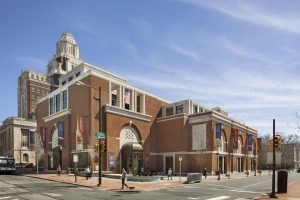 Ian Volner’s review of Robert A. M. Stern’s Museum of the American Revolution in Philadelphia is more even-handed that Inga Saffron’s mean-spirited screed in the Inquirer. But both critics miss an important aspect of Stern’s design: its relation to the nearby U.S. Custom House. That 17-story tower is the most prominent building in the area and provides a backdrop to the museum, evident in Peter Aaron’s evocative photograph. The museum echoes some of the brick and limestone details, as well as the crowning lantern. The Custom House, a WPA project completed in 1934, was the work of Verus T. Ritter and Howell L. Shay (Shay had worked for Horace Trumbauer, and is credited with the parti for the latter’s Philadelphia Museum of Art). The brick and limestone Custom House combined an Art Deco sensibility with Federal details and forms in a masterly way. Thus Stern’s museum, far from being latter-day Georgian revival, as both Volner and Saffron suggest, is really a twenty-first century interpretation of an early twentieth century take on American Federal, which itself was a version of British Georgian. Personally, I find the recessed arches of the museum’s facade to be a little heavy-handed, but the dialogue with the many pasts of Philadelphia is interesting and bears mention. Incidentally, Saffron suggests that there is something unseemly in using Georgian stylistic references in a building commemorating a war fought “to free ourselves from the Georgian tyranny.” But the Founding Fathers were not revolting against British civilization, only British rule; in architecture they were content to take their lead from their British cousins.
Ian Volner’s review of Robert A. M. Stern’s Museum of the American Revolution in Philadelphia is more even-handed that Inga Saffron’s mean-spirited screed in the Inquirer. But both critics miss an important aspect of Stern’s design: its relation to the nearby U.S. Custom House. That 17-story tower is the most prominent building in the area and provides a backdrop to the museum, evident in Peter Aaron’s evocative photograph. The museum echoes some of the brick and limestone details, as well as the crowning lantern. The Custom House, a WPA project completed in 1934, was the work of Verus T. Ritter and Howell L. Shay (Shay had worked for Horace Trumbauer, and is credited with the parti for the latter’s Philadelphia Museum of Art). The brick and limestone Custom House combined an Art Deco sensibility with Federal details and forms in a masterly way. Thus Stern’s museum, far from being latter-day Georgian revival, as both Volner and Saffron suggest, is really a twenty-first century interpretation of an early twentieth century take on American Federal, which itself was a version of British Georgian. Personally, I find the recessed arches of the museum’s facade to be a little heavy-handed, but the dialogue with the many pasts of Philadelphia is interesting and bears mention. Incidentally, Saffron suggests that there is something unseemly in using Georgian stylistic references in a building commemorating a war fought “to free ourselves from the Georgian tyranny.” But the Founding Fathers were not revolting against British civilization, only British rule; in architecture they were content to take their lead from their British cousins.
On Culture and Architecture

“A forcible overthrow of a government or social order, in favour of a new system.”
Timing is everything, The Stern building was designed prior to the recent political kleptocracy coming to power. Today the fragile qualities of our democracy and institutions are being forcibly challenged. Meanwhile the leadership (vacuum) is torn between the blind lust of power and the blender speed hypocrisy gushing out of the white house fenestration.
I’m confident the Stern building has met most stakeholder expectations. I don’t think you hire RAM with hopes of being surprised. You hire him to maintain the status quo. The building could house most anything required to be near Philadelphia’s historic district and sure it looks as though the Customs House had a pup. But in hindsight, it seems to me this building could be more than just another good neighbor. Recent political events are challenging our lives, beliefs, leaders and institutions. I believe the recent events would have also challenged the architects and stakeholders if they had a window to the future:
What is a fitting container of the history of the American Revolution?
What role does the American Revolution play in our modern lives?
Can architecture speak truth to power?
Is the American Revolution a living thing?
Are truths self-evident?
All men (and women) are created equal, why can’t we live as equals?
Will you place your life, your family in jeopardy to defend what you believe in?
What do you believe in?
What does it mean to be an American?
Who are we?
Today the questions are difficult, and the answers remain to be seen. I think the seed of this building is different today than it was ten years ago. We are all being challenged to stay focused, to run the long race. Today our lives and our country once again depend on revolutionary dna, our American spirit.
Your comments are from a functionalist perspective, that is, the view that a building should express its contents. Buuildings in the past have done this with some sort of iconographic program (the Lincoln Memorial), but not by their overall arrangement. Nearby Independence Hall, for example, built in 1751 as a state house, later served as the locale for the signing of the Declaration of Independence and the Constitutional Convention. (The iconic steeple was added by Strickland in 1828.) The building successfully morphed into a national symbol of the signing (and the location of the Liberty Bell) precisely because it was designed as a generic “civic building.” In that sense you are correct that Stern’s design could house almost anything. I consider that a plus.